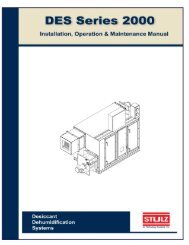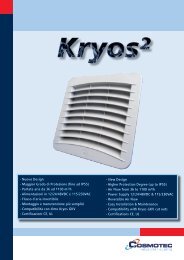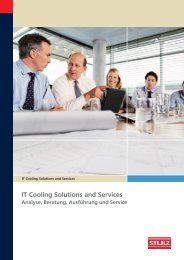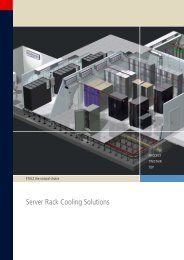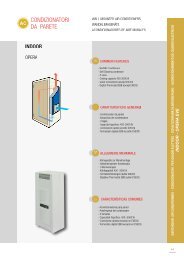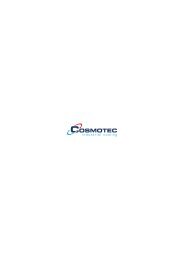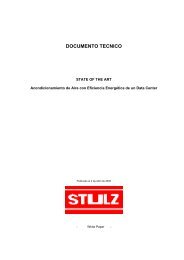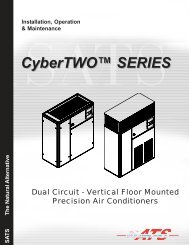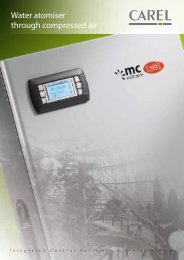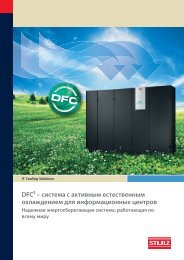Mini-Space Series Installation, Operation & Maintenance Manual
Mini-Space Series Installation, Operation & Maintenance Manual
Mini-Space Series Installation, Operation & Maintenance Manual
Create successful ePaper yourself
Turn your PDF publications into a flip-book with our unique Google optimized e-Paper software.
<strong>Mini</strong>-<strong>Space</strong> <strong>Series</strong> <strong>Installation</strong>, <strong>Operation</strong> & <strong>Maintenance</strong> <strong>Manual</strong>vapor form. Cylinders which are not provided with diptubes should be inverted to allow only liquid refrigerantto charge the system. Keeping the temperature ofthe cylinder below 85°F will help maintain the correctrefrigerant composition while the cylinder is emptied.CAUTIONPOE oil is used in systems with R407C refrigerant.POE oil quickly absorbs moisture whenexposed to air. High POE oil moisture levelsreact with refrigerant to form acid, which resultsin system contamination. Keep the entire systemsealed as much as possible and minimizeexposure of POE oil to outside air.Familiarize yourself with the charging proceduresdiscussed in Section 2.9.1 of this manual. Instead ofadding R22 vapor to the suction port as describedunder “Preparing System for Charging”, the initialcharge will be performed by introducing R407C liquidto the discharge side of the compressor. (See thefollowing steps.)PREPARING SYSTEM FOR CHARGING1. With all the system piping connections made,perform a dry nitrogen leak detection test on thesystem. Using dry nitrogen only, pressurize thesystem to 150 psig. Since there is no refrigerantin the system to detect, leaks may be detected byobserving the standing pressure.2. After ensuring there are no leaks, evacuate thesystem to 50 microns and hold the vacuum for 2hours minimum.3. Break the vacuum by supplying R407C liquid tothe discharge port near the compressor until thepressure is raised to about 50 psig. This smallholding charge allows the low pressure switchto “make” through the process of fine tuning thesystem charge.FINE TUNING THE SYSTEM CHARGE4. Disconnect the refrigerant cylinder from the dischargeside of the compressor and connect it tothe suction side.5. Referring to Section 3.0, start the system anduse the microprocessor controller to lower thetemperature setpoint 3-5°F below room temperature,ensuring cooling remains on as the unit ischarged.6. Allow the discharge pressure to rise to 225-280psig and hold it constant. On cool days it may benecessary to restrict the airfl ow across the condenser(or reduce the water glycol fl ow), to raisethe pressure.7. Slowly meter R407C liquid refrigerant through thesuction side while watching the sight glass to clearof bubbles.CAUTIONAdd liquid refrigerant slowly to prevent the refrigerantoil from “washing out” of the compressor.8. Take a superheat temperature reading on thesuction line near the feeler bulb from the thermalexpansion valve. The ideal superheat temperatureis 12-15°F. The maximum allowable superheattemperature is 20°F.9. While monitoring the sight glass, take a subcoolingtemperature reading on the output side of thecondenser. The subcooling temperature shouldbe 10-20°F.10. If necessary, add liquid refrigerant to maintainadequate subcooling temperature.2.9.2.1 Flooded Head Pressure Control SystemsIn units with R407C refrigerant using fl ooded headpressure control, a receiver is provided to store therefrigerant during the time the condenser is not usingthe extra refrigerant charge. Once a clear sight glasshas been achieved, additional refrigerant must beadded to the receiver.A level indicator is located on the side of the receiverto assist the service technician in chargingthe air conditioning system. The proper charge canbe determined by viewing the position of the “fl oatball” while the unit is running. If the “fl oat ball” ispositioned at the bottom of the sight indicator, additionalrefrigerant charge is needed. When the “fl oatball” reaches the top of the indicator, the unit is fullycharged.(©April, 2008)2-16Air Technology Systems, Inc.



